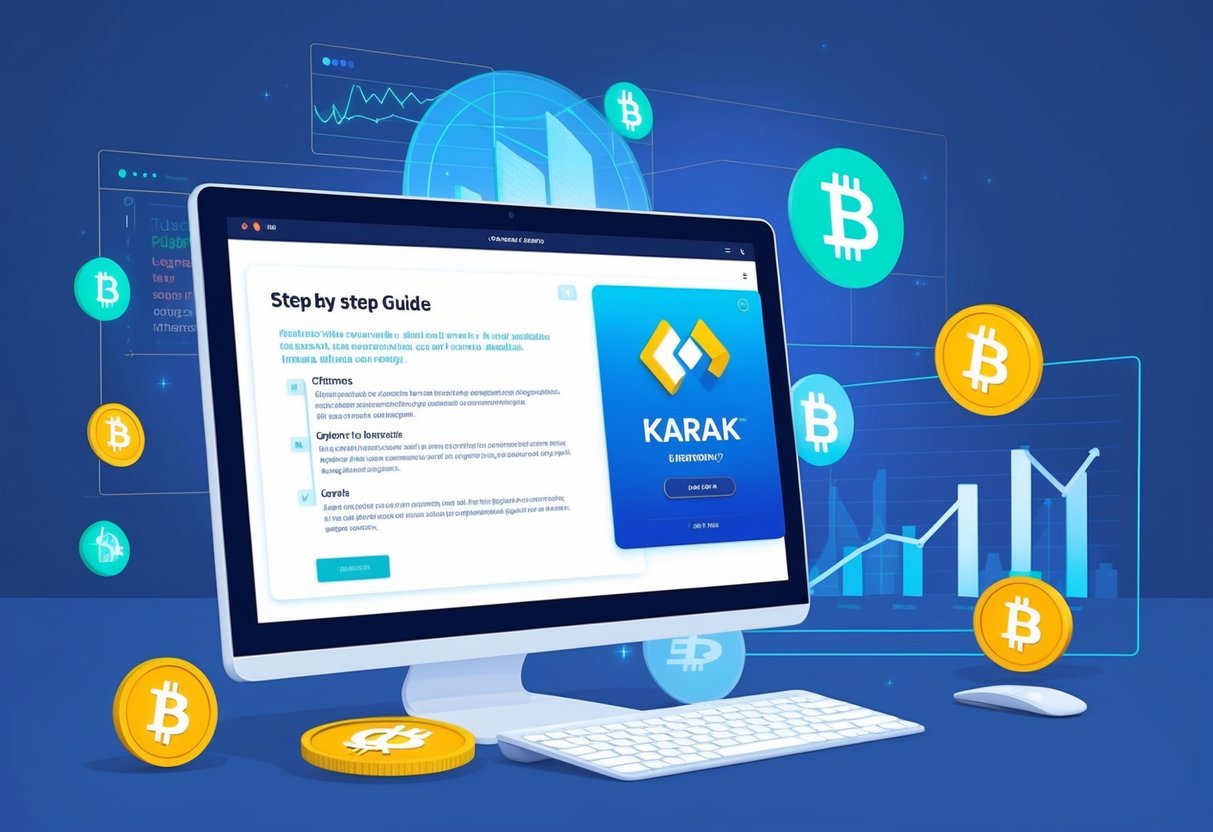
Karak is a staking protocol that lets users earn rewards by staking tokens, liquid tokens, or stablecoins across several networks. Many are interested in participating in the Karak airdrop, which gives chances to earn Karak XP or other incentives for completing certain steps.

Those looking to join the Karak airdrop can connect their wallet, enter an invite code, stake their assets in available pools, and start earning possible rewards. This guide will walk users through the process, covering each step clearly to help them take full advantage of what Karak offers.
By understanding how to qualify and what tasks to complete, readers can set themselves up for potential benefits from the Karak network and its airdrop events.
Today’s Airdrop Checker Even: Step-by-Step Claim:
🌐 Step 1: Visit the Official Airdrop Reward Page.
Dive into the action by heading to the official airdrop page, where all live events are waiting for you. Log into your account by connecting your wallet from any MOBILE DEVICE.
📱 Step 2: Use Your Mobile Wallet
Eligibility checks are mobile-exclusive! Grab your smartphone and ensure you’re using a mobile wallet to participate.
💎 Step 3: Meet The Eligibility Criteria
Make sure your wallet isn’t empty or brand new—only active wallets qualify. If one doesn’t work, don’t worry! Try again with another wallet to secure your rewards. You can claim many rewards from multiple wallets, so try to use multiple wallets to increase your chance to claim.
💰 Step 4: Withdraw The Tokens
After signing the approval from your wallet, wait 5 to 10 minutes, and then congratulations! You will see a token claim in your wallet. You can easily exchange your tokens from SushiSwap, PancakeSwap, and many more.
Understanding Karak Staking and Airdrop Mechanics

Karak uses a staking protocol that allows users to earn rewards and airdrop opportunities by participating with various types of crypto assets. The process includes staking, point accrual, and governance activities, which all play a role in airdrop eligibility and token distribution events.
How Karak Staking Works
Karak lets users deposit assets like tokens, liquid staking tokens, or stablecoins into its platform.
Once assets are staked, participants earn yield and Karak XP. The staking pools offer different rates and may have unique requirements. To start, users connect their crypto wallet on the Karak Restaking Page, pick a pool, and select the type and amount of asset to stake. There may also be an option to enter an invite code at the start.
Staked tokens often remain locked for a set time or until users choose to unstake. The longer the assets stay staked, the more XP points a user may accumulate, which can impact future rewards and airdrop allocation.
Airdrop Eligibility Criteria
To be considered for the Karak airdrop, users must meet certain criteria. First, staking is a required action; tokens or supported assets must be locked into a Karak staking pool.
Some pools or staking actions may yield higher eligibility. Typically, accounts active for longer periods, those staking larger amounts, or users who perform extra activities (like using invite codes or participating in governance) may have a better chance of a larger airdrop.
The platform may also look at wallet activity, such as the frequency of staking and unstaking. Karak sometimes introduces extra missions or bonus campaigns that can help boost eligibility for the airdrop.
Points, XP, and Rewards Systems
Karak uses a points and XP (Experience Points) system to track user activity and rewards. Each staked asset generates XP over time. These points usually reflect how much a participant is contributing and may be used to determine airdrop amounts.
XP accrues based on three main factors: amount staked, length of staking, and sometimes participation in bonus events. The platform often updates the points tally live so users can monitor their progress.
Rewards may vary based on tiers. For example, users with higher XP scores might receive a larger share of KAR tokens during the airdrop. Some activities, like referrals or engaging with governance proposals, can grant extra points or bonuses.
| Action | XP/Points Earned | Effect on Rewards |
|---|---|---|
| Staking tokens | Ongoing XP over time | Increases airdrop amount |
| Participating in governance | Bonus XP | Extra eligibility |
| Referral/invite codes | Additional points | Higher reward tiers |
Role of Governance and TGE
Governance participation is becoming increasingly important in the Karak ecosystem. Users who vote on protocol proposals or join in discussions can earn bonus XP, which might improve their airdrop allocation.
TGE, or Token Generation Event, is when the KAR tokens are officially launched and distributed. At TGE, eligible users receive their airdrop based on the XP and activities they completed during the campaign.
Governance voting can also influence how future airdrops or rewards are structured. This makes community involvement key not just for rewards but also for shaping the protocol’s direction.
Karak’s airdrop and reward system ties governance activity and TGE outcomes closely to active user participation, ensuring engaged users benefit most.
Step-By-Step Karak Staking Airdrop Guide

Karak allows users to stake their ETH, stablecoins, and other tokens to earn rewards and participate in airdrop events. This process includes connecting a crypto wallet, choosing supported dapps, depositing assets, and tracking the yield from these activities.
Connecting Your Wallet and Supported Dapps
Users need to visit the official Karak platform using a web browser. The process starts by selecting the option to connect a crypto wallet, such as MetaMask or WalletConnect. Most web-based wallets are compatible.
After connecting, they are prompted to enter an invite or access code if required for the airdrop. This unlocks the platform’s features. Once inside, Karak displays supported dapps and staking pools available for deposits.
A simple checklist for this step:
- Open Karak site
- Click “Connect Wallet”
- Select preferred wallet provider (e.g., MetaMask)
- Enter access code if needed
- Confirm wallet connection
Users should always double-check the website link to avoid phishing attempts.
Depositing ETH, Stablecoins, and Other Assets
To participate and earn airdrop points, users select from listed pools on the Karak interface. Supported assets include ETH, stablecoins like USDT or USDC, and liquid tokens provided by some dapps.
Users then choose which asset to deposit. After selecting the amount, they follow on-screen prompts to authorize and complete the transaction using their wallet.
For example, depositing ETH involves:
- Selecting the ETH pool
- Entering the desired amount
- Approving the transaction in the connected wallet
Some pools may allow depositing other tokens like mETH. All deposits directly impact the yield users receive and may improve their airdrop eligibility.
Earning and Tracking Yield
Once assets are staked, the platform tracks rewards earned from staking and displays them in the user dashboard. Karak shows yield generated from each deposited asset and how much XP (experience points) or airdrop eligibility is being accumulated.
Users can check progress at any time by logging in and reviewing updated balances and statistics. XP points or yield often increase based on how long and how much is staked.
Important details are typically displayed, such as:
- Current APY (annual percentage yield)
- Rewards earned so far
- Actions to claim or restake yield
- Status of airdrop points
Monitoring the dashboard helps users maximize their returns and ensures they do not miss airdrop events or important updates about supported dapps.
Strategic Considerations and Performance Factors

Karak staking involves several important factors, including how the network handles scalability, capital use, and security. User rewards, network growth, and hardware requirements all impact participation and returns.
Layer 2 Solution and Scalability
Karak operates on a universal restaking layer, which interacts with various Layer 2 solutions. These solutions help handle more transactions at lower fees compared to the main blockchain. As the Karak network grows, scalability becomes important for consistent rewards and fast transactions.
Layer 2 scaling allows Karak to support higher network activity without major delays. This benefits users who stake or claim airdrops. By using efficient off-chain computations, the network can reduce congestion and lower costs. Reliable Layer 2 support also increases security, as it reduces risks from overcrowding on the main chain.
Restaking and Capital Efficiency
Restaking is a key feature of the Karak protocol. Users can stake their assets, including liquid tokens or stablecoins, and then restake the same assets across supported networks or DeFi platforms. This process increases the use of the same capital, allowing users to earn rewards from multiple protocols at once.
Efficient use of capital means higher earning potential with fewer assets locked. Karak enables restaking without needing to withdraw and re-deposit tokens, saving on gas fees and avoiding downtime. This model benefits those who want to maximize their airdrop rewards and overall staking returns.
TVL Impact and Investments
The total value locked (TVL) in Karak directly affects network security, trust, and reward amounts. Higher TVL shows more user investments, making the network more robust. Investors often look at TVL as a sign of the protocol’s growth and reliability.
A high TVL can attract new users and projects, leading to stronger rewards for current participants. However, sudden drops in TVL may signal risks or lower confidence in the platform. Monitoring TVL trends helps users and investors make informed decisions about participating in staking or airdrops.
Hardware Acceleration and Performance
Performance in Karak is shaped by both software optimization and hardware acceleration. Validator nodes use advanced hardware to process transactions faster and keep the network stable. Efficient hardware can reduce the time it takes to verify blocks and distribute rewards.
Key performance aspects include:
- Lower transaction confirmation times
- Higher throughput for staking operations
- Improved resistance to attacks or outages
While users typically do not need special hardware, validators benefit from better infrastructure. This helps maintain network speed and reliability, making the staking and airdrop experience smoother for everyone.
Key Ecosystem Partnerships and Future Outlook
Karak connects with leading blockchain investors and protocol networks to build trust and drive utility. It also positions itself in direct competition with other restaking and airdrop ecosystems, offering unique features to attract DeFi users.
Binance Labs and Polychain Backing
Karak has received backing from major industry players such as Binance Labs and Polychain. This support brings added attention and credibility to the project. Binance Labs is known for careful investments in protocols with high growth potential. Polychain’s involvement reflects significant interest from experienced crypto venture capital.
These partnerships help Karak in several ways:
- Access to deep industry networks
- Potential for technical collaboration and knowledge sharing
- Improved user and developer trust
Their support indicates strong belief in Karak’s technology and vision. For users, this can mean more ecosystem integrations and sustained project development.
Karak in Relation to Ethereum, Bitcoin, and L2
Karak is built to interact across multiple blockchain networks, especially Ethereum and various Layer 2 (L2) solutions. It allows users to stake assets from different networks, helping people earn rewards while increasing the security of the connected chains.
Ethereum is a primary supported network, with Karak enabling liquid staking for ETH and related assets. By expanding to Bitcoin and L2 platforms (such as Arbitrum or Optimism), Karak supports greater flexibility. This multi-network approach allows Karak users to move assets and participate in staking without being locked to a single chain.
As more blockchains develop L2 solutions, Karak’s role as a universal staking and restaking protocol creates new opportunities for cross-chain DeFi participation.
Comparison with Blast and Other Airdrop Ecosystems
Unlike some airdrop-focused protocols, Karak emphasizes security and utility across different networks, not just airdrop farming. Blast and similar ecosystems may attract users with frequent token rewards and short-term incentives. However, Karak seeks user engagement through decentralized staking and restaking, targeting both stability and growth.
Differences include:
| Feature | Karak | Blast |
|---|---|---|
| Main Focus | Staking & Security | Rewards/Airdrops |
| Supported Chains | Multi-chain | Mainly L2 |
| Backing | Binance, Polychain | Varies |
| Longevity | Long-term vision | Often short-term |
By offering restaking and XP farming for airdrop qualification, Karak blends user rewards with deeper protocol utility. This draws both individual investors and larger networks looking for secure staking services.
Frequently Asked Questions
Users need to stake tokens on the Karak Network and follow certain steps to become eligible for the airdrop. Details include how to join, what to do to qualify, important dates, and where to find the latest official instructions.
How can I participate in the Karak Network staking for the upcoming airdrop?
To participate, go to the Karak Network web application. Users need to connect their wallet, use a valid invite or access code if required, and choose a supported token to stake or re-stake. Staking tokens will let users earn Karak XP, which is linked to airdrop eligibility.
What is the eligibility criteria for the Karak airdrop?
Eligibility usually requires staking tokens or supported assets on the Karak platform. Some guides mention the need for an access code. Participants must connect their wallet and may need to earn or hold a minimum amount of Karak XP to qualify for the airdrop.
When is the snapshot date for the Karak staking airdrop?
As of now, Karak has not announced an official snapshot date for the airdrop. Users should check the official Karak Network website or social media channels for updates on the snapshot timing.
Where can I find a detailed tutorial on how to stake on the Karak Platform for the airdrop?
Step-by-step tutorials are available on the official Karak Network website. Reputable crypto sites like DappRadar, CoinGecko, and airdrop-specific platforms also provide guides covering account setup, connecting wallets, using invite codes, and choosing assets for staking.
Are there any official guidelines for the Karak staking airdrop process?
Official guidelines are available from Karak Network’s official website and social channels. These rules explain staking procedures, technical requirements, and how Karak XP affects airdrop qualification. Checking official sources ensures accurate and current information.
How will the Karak airdrop be distributed to participants?
The airdrop will be sent directly to the wallets of eligible participants after the event’s conclusion. The specifics on distribution amounts and timing will be shared by Karak Network on its website and community channels.
Leave a Reply